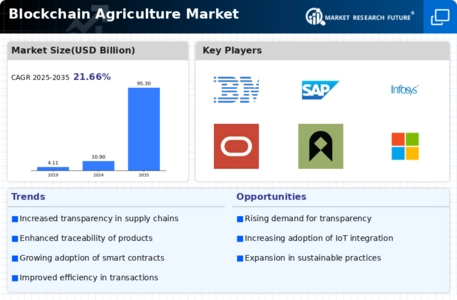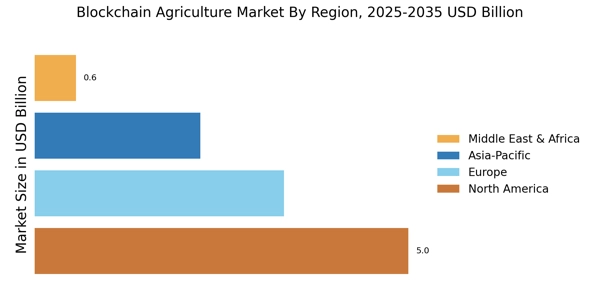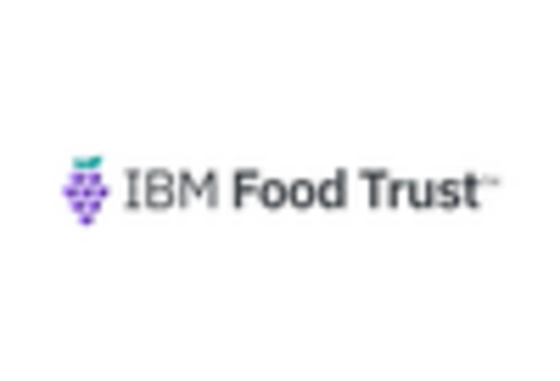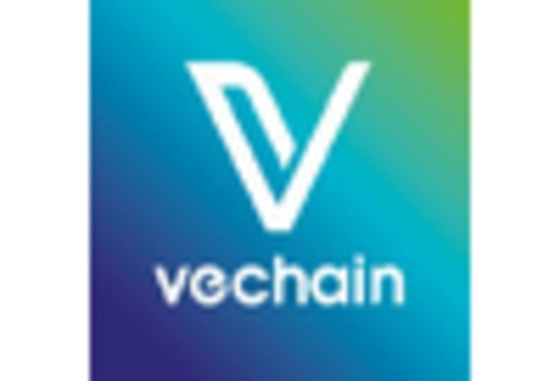The Blockchain Agriculture Market is currently characterized by a dynamic competitive landscape, driven by the increasing demand for transparency, traceability, and efficiency in agricultural supply chains. Key players are actively engaging in strategic initiatives that enhance their operational capabilities and market presence. For instance, IBM (US) has positioned itself as a leader in this space by leveraging its robust blockchain technology to facilitate food safety and traceability. The company’s focus on partnerships with agricultural stakeholders, including farmers and retailers, underscores its commitment to fostering innovation and enhancing supply chain transparency. Similarly, VeChain (CN) has been making strides in the market by integrating IoT with blockchain solutions, thereby enabling real-time tracking of agricultural products from farm to table. This strategic alignment not only enhances product authenticity but also builds consumer trust, which is increasingly vital in today’s market.
In terms of business tactics, companies are increasingly localizing their operations and optimizing supply chains to respond to regional demands effectively. The market appears moderately fragmented, with several players vying for dominance. However, the collective influence of major companies like AgriDigital (AU) and Provenance (GB) is notable, as they continue to innovate and expand their service offerings. AgriDigital, for example, focuses on streamlining the grain supply chain through its blockchain platform, which facilitates secure transactions and enhances operational efficiency.
In August 2025, Ripe Technology (US) announced a strategic partnership with a leading agricultural cooperative to implement its blockchain-based platform for crop management. This collaboration is expected to enhance data sharing among farmers, thereby improving yield predictions and resource allocation. The strategic importance of this partnership lies in its potential to revolutionize how agricultural data is utilized, ultimately leading to more sustainable farming practices.
In September 2025, OriginTrail (SI) launched a new initiative aimed at integrating AI with its blockchain solutions to enhance supply chain analytics. This move is particularly significant as it positions the company at the forefront of technological innovation in agriculture, allowing for more informed decision-making and improved operational efficiencies. The integration of AI is likely to provide a competitive edge, enabling OriginTrail to offer advanced insights into supply chain dynamics.
Moreover, in October 2025, TE-FOOD (AT) expanded its blockchain traceability solutions to include a wider range of agricultural products, thereby enhancing its market reach. This expansion reflects a strategic effort to cater to the growing consumer demand for transparency in food sourcing. By broadening its product offerings, TE-FOOD is likely to strengthen its competitive position in the market.
As of October 2025, the competitive trends in the Blockchain Agriculture Market are increasingly defined by digitalization, sustainability, and the integration of advanced technologies such as AI. Strategic alliances among key players are shaping the landscape, fostering innovation and enhancing supply chain reliability. The shift from price-based competition to a focus on technological advancement and sustainable practices is evident, suggesting that future competitive differentiation will hinge on the ability to innovate and adapt to evolving market demands.


















Leave a Comment